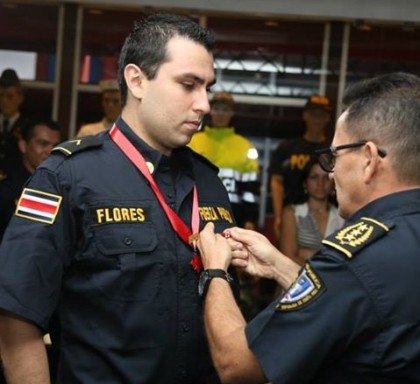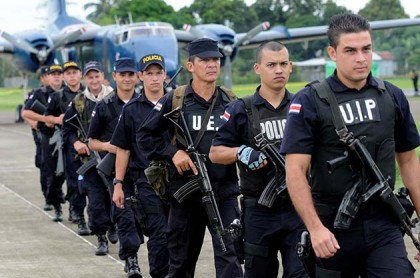
Fuerza Publica Officer Juan Carlos Flores Mena receives the Scarlet Cross after recovering from a gunshot wound. Officer Flores shot and killed an armed robbery suspect near the University of Costa Rica in Montes de Oca.
Questions about public security are common among those considering relocation to Costa Rica. Recent murders of United States citizens, Kurt Hergis in La Fortuna this week and Stephen Rutkiewicz in Guanacaste in December have brought the topic to the center of attention.
Unfortunately, objective answers can difficult because so many who respond in English have a vested interest in attracting new residents who are flush with cash. For example, you should be at least a little skeptical of advice from real estate agents and relocation tour operators.
Objective statistics paint Costa Rica (10 murders per 10,000) as a small, relatively less violent country in what is one of the most violent regions in the world, Central America (28.5 murders per 10,000). Comparatively the United States has one of the lowest murder rates in the world (4.7 per 10,000). In Canada the rate is even lower (1.6 per 10,000). The numbers come from worldwide statistics published by the United Nations in 2012.
Many Costa Ricans have an inaccurate view of relative crime rates because the occasional mass shooting in the United States tends to dominate the global news. Violence in the United States for the most part is concentrated in troublesome urban centers, such as Detroit (54.6 murders per 100,000) or Baltimore (34.9 murders per 100,000). However, overall rates for murder remain low in the United States because it is a country of 313 million people.
Overall Costa Rica, with just 4.8 million people is by population a more violent place than the United States. Some argue that much of the violence “spills over” from Central and South America, due to the drug trade. Nearby Honduras (91.6 murders per 10,000) and El Salvador (69.2 murders per 10,000) are the two most violent countries in the world. A Deputy Security Minister echoed this sentiment, which is foreigners are behind the crime in Costa Rica in recent remarks about illegal immigration and slums.
Wholly domestic events like the murder in January of a teenage couple in a relatively peaceful Cartago, and the contract killing of an elderly man in Pococi may give some pause. In December, the shooting of a pregnant women in the stomach during a robbery was especially gruesome.
After the incident, Francisco Segura, director of the Judicial Investigative Police (OIJ) made the comment that there now exists a total total disregard for human life among the criminal element in Costa Rica. He also cited examples where shootings now typically involve multiple gunshots and beatings before the execution. One such example is environmental activist Jairo Mora who was beaten to death by narcotics traffickers.
Violence in rural areas of Costa Rica is particularity disturbing because there is often no one coming to the rescue. A good example is a 74 year old rancher in Tilarán who was found with a knife sticking out of his neck in January. Expats in isolated areas can feel vulnerable because most legal residents can not qualify for a gun permit until after they have lived in the country for three years.
Home invasions where electronics, jewelry and cash are taken are frequent events in Costa Rica. A recent example was Costa Rican television personality, Aunty Florita.

Costa Rican police patrol disputed border region in conflict with Nicaragua. (Photo EFE / Jeffrey Arguedas)
Many expats only tend to notice the violence when it affects their own peer group or comes into their community. There is very little English language coverage of the shootings and murders that persist in southern San Jose or the Caribbean coast. In fairness, the drug fueled violence in these areas is precisely the kind of thing that is not likely to affect a tourist or expat directly. It’s also the reason why there are so many police officers in Costa Rica. However, violence has a tendency to eventually cross borders and social divisions.